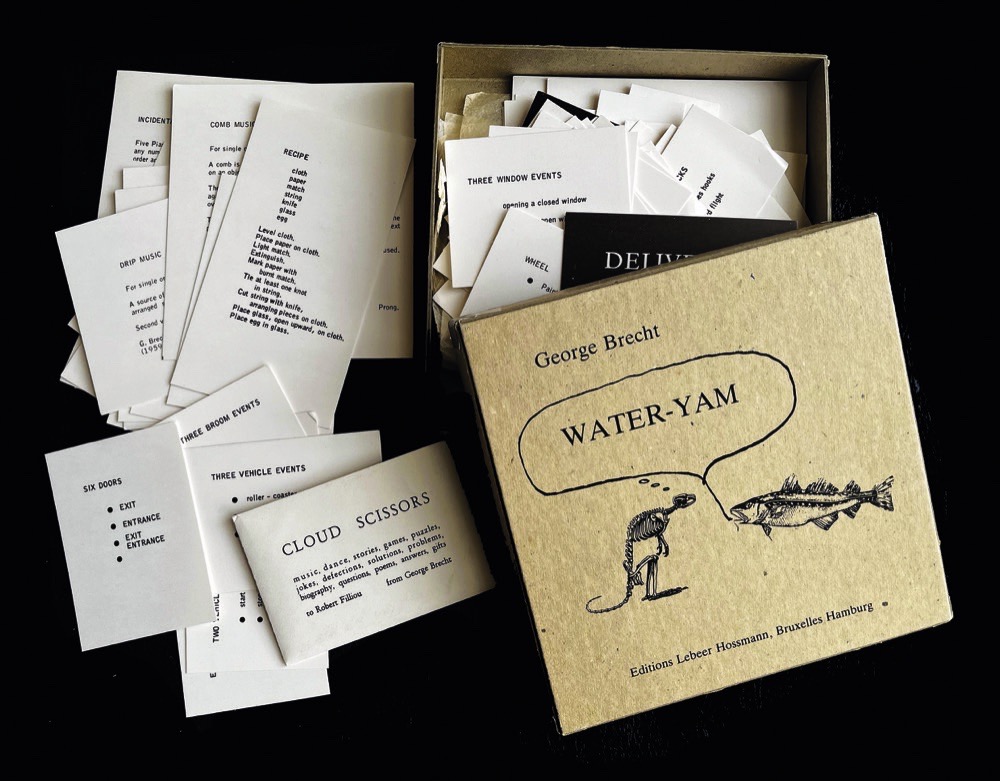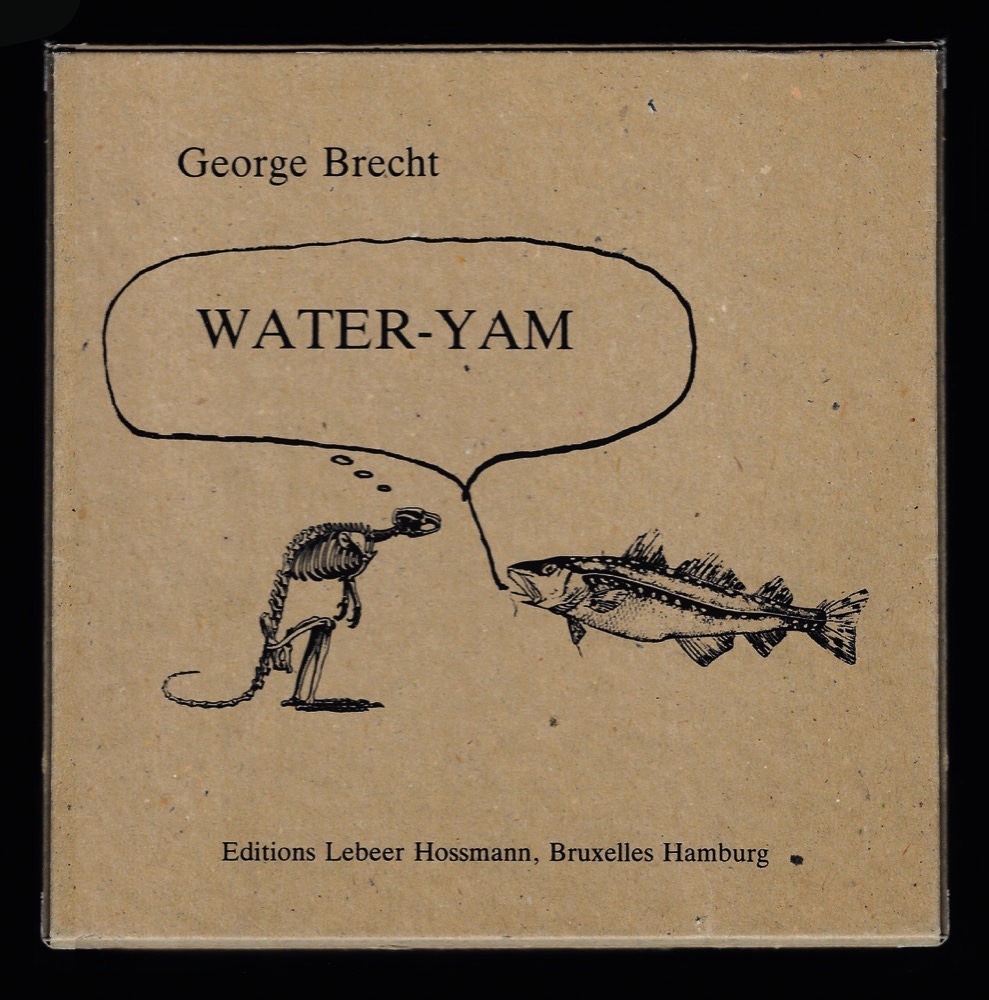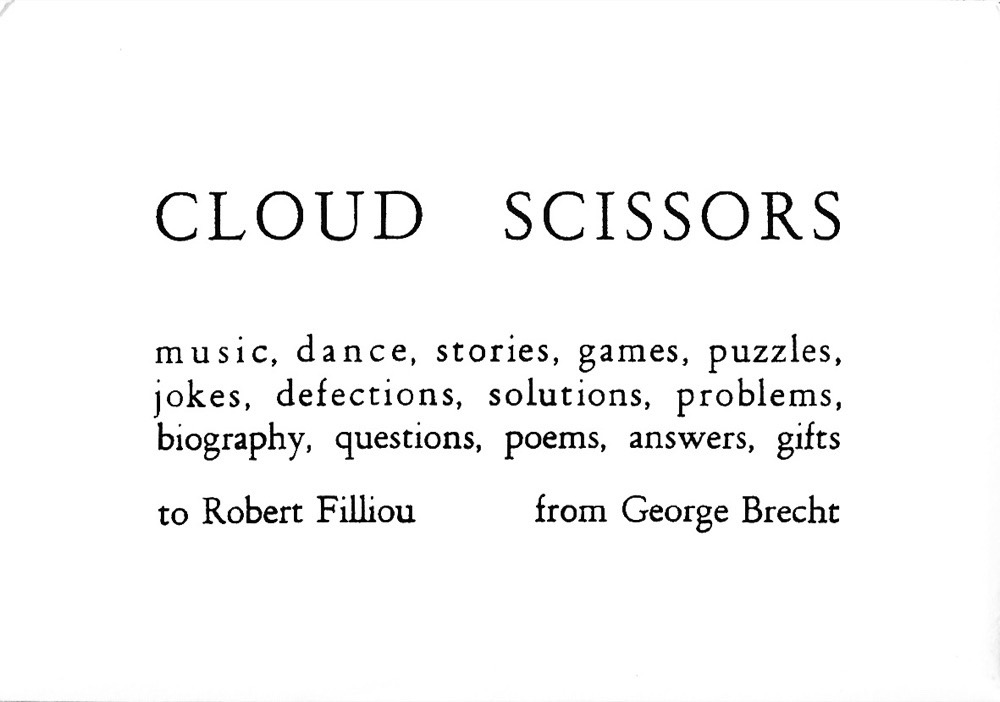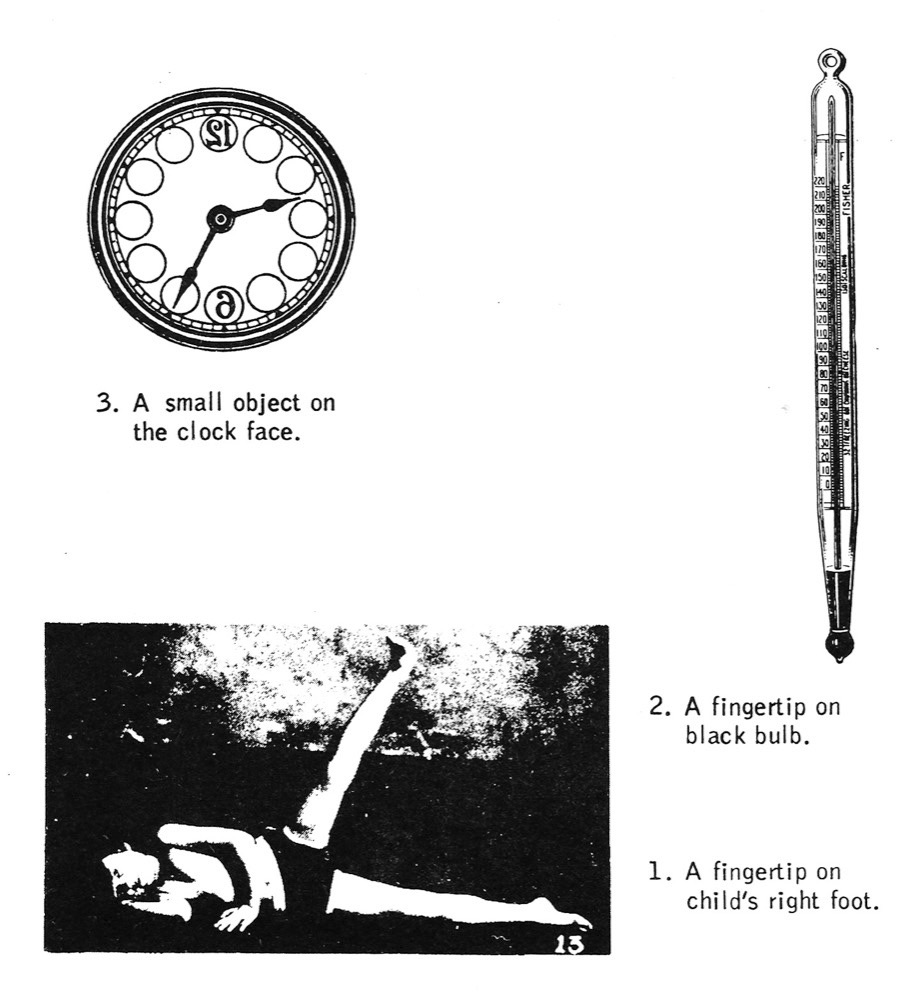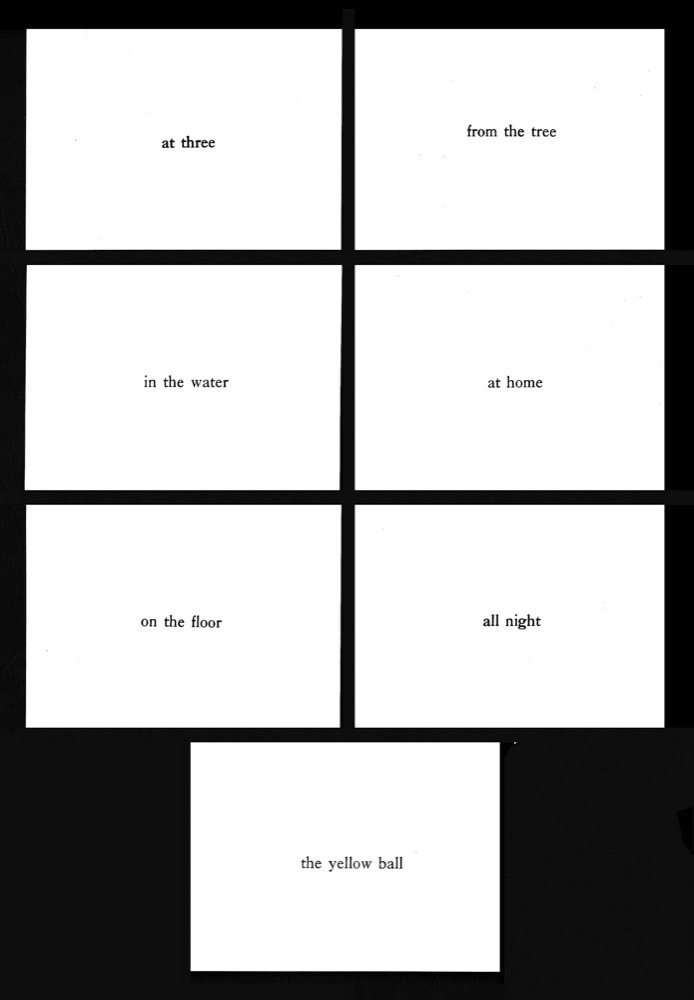BRECHT George
[George Ellis MacDiarmid] (New York 1926 - Colonia 2008)
Water-Yam [1986]
Luogo: Brusselles - Hamburg
Editore: Editions Lebeer Hossmann
Stampatore: senza indicazione dello stampatore
Anno: 1986 (ottobre)
Legatura: scatola di cartone
Dimensioni: 17x17x3 cm.
Pagine: N. D.
Descrizione: copertina illustrata con un disegno di George Brecht su fondo grigioverde. La scatola contiene 87 cartoncini di varie dimensioni di cui 85 bianchi e 2 neri, e una bustina contenente 7 cartoncini: «Cloud Scissors... to Robert Filliou from George Brecht». Mancano dunque 8 cartoncini su 102 complessivi. Firma autografa di George Brecht al retro del coperchio della scatola, sotto la giustificazione della tiratura. Edizione in parte originale.
Bibliografia: Archivio della Fondazione Luigi Bonotto: Code 0329E 1/6; BUCHHOLZ – MAGNANI 1993: Daniel Buchholz – Gregorio Magnani, «International Index of Multiples from Duchamp to the Present», Tokyo – Köln, Spiral / Wacooal Art Center – Verlag der Buchhndlung Walther König, 1993: pag. 44
Prezzo: € 250ORDINA / ORDER
Al retro del coperchio della scatola c'è la giustificazione della tiratura con una nota storica in inglese, francese e tedesco: "George Brecht's Water-Yam first appeared in 1962 (Fluxus Editions, Wiesbaden and New York). Second and more complete edition: Fluxus, NYC, 1964. Third Edition of 100 copies (signed and numbered): Daniel Templon, Paris, 1972. Fourth edition: Parrot Impressions, Surbiton/Surrey (UK). This unlimited edition in published by Lebeer Hossmann, Brussels and Hamburg". La versione tedesca fa questa precisazione: "Die gegenwärtige, und die Serie «Cloud Scissors» von 1961 erweiterte, unlimitierte Ausgabe von 102 Karten erscheint im Oktober 1986...". In realtà, come documenta il «Fluxroll» la prima edizione è del 1963. Inoltre in ogni scatola il numero e i titoli dei cartoncini variano, come anche in questa edizione Hossmann.
Alla fine del 1962 George Brecht e Robert Watts mettono a punto un progetto 'for all manner of immaterial, experimental, as yet unclassified forms of expression" («George Brecht Events. A Heterospective», Robinson, Walter König, pag. 68), e decidono di designarlo con la parola «Yam». Lo yam (o igname) è un tubero commestibile, prodotto dalle piante del genere Discorea, ma nell'America del Nord, la parola indica più comunemente la patata dolce. La scelta di questo nome è in sintonia con l'obiettivo dei due artisti: organizzare un festival in cui gli eventi e le opere prendendo spunto dalla vita quotidiana, si offrano come momenti e oggetti su cui riflettere, sottratti al mercato dell'arte, cose che non si possono comprare. Lo Yam Festival inizia il 19 maggio 1963, presso una fattoria a South Brunswick nel New Jersey e durerà un mese, attraverso una lunga serie di eventi a New york, alla Rutger University e nella fattoria di George Segal. Fra i numerosi artisti partecipano John Cage, Dick Higgins, Allan Kaprow, La Monte Young, Wolf Vostell, Alison Knowles e altri protagonisti di Fluxus: "In all of its formats and strategies Brecht's and Watt's Yam Festival operated as an alternative to the gallery system, producing «art» that could not be bought" (Julia Robinson, in «George Brecht Events. A Heterospective», Robinson, Walter König, pag. 68). Lo Yam Festival si svolge in contemporanea con la Fluxfest di George Maciunas, una manifestazione identica nello spirito allo Yam Festival ma di matrice europea, dato che Maciunas viveva in Germania.
Elenco dettagliato dei cartoncini:
- Candle-piece for radios, 1959.
- Card-piece for voice, 1959.
- Time-table-music, 1959.
- Drip music (Drip Event), 1959-1962.
- Spanish card piece for objects, 1960.
- Motor vehicle sundown (event) ,1960.
- Incidental music, 1961.
- Mallard milk, 1961.
- Three telephone events, 1961.
- Time-table event, 1961.
- Three chair events, 1961.
- Three gap events, 1961.
- Three Yellow Events, 1961.
- Word event, 1961.
- Two vehicle events, 1961.
- Three lamp events, 1961.
- Three aqueous events, 1961.
- Tea event, 1961.
- Three dances, 1961.
- Two elimination events [Empty vessel], 1961.
- Six exhibits, 1961.
- Exhibit seven (clock), 1961.
- Comb music, 1961.
- Two exercises. Consider an object. Call what is not the object other..., 1961.
- 3 Piano pièces, 1962.
- Solo for wind instrument, 1962.
- String quartet, 1962.
- Organ piece, 1962.
- Solo for violin viola cello or contrabass,, 1962.
- Flute solo, 1962.
- Concerto for clarinet, 1962.
- Concert for orchestra, 1962.
- Saxophone solo, 1962.
- Ladder, (1962).
- Wheel [Paint the hub white] (1962).
- Chair event [On a white chair - a grater - tape measure...] (1962).
- Stool [On a Stool - A cane...] (?).
- Stool [On or near] (1962).
- Stool [On a white stool], 1962.
- Table, (1962).
- Table [On a white table], (1962).
- 3 Table and chair events, (1962) - Newspaper.
- Suitcase, (1962).
- Suitcase [From a suitcase], (1962).
- Suitcase [Black suitcase] ,(1962).
- Dresser [Mirror above], (1962).
- Sink [On a white sink], (1962).
- Bed event [A white bed], (1962).
- Three arrangements [On the shelf], (1962).
- Event. Pulse - start / Pulse - stop, (1962).
- Intermission [Hair growing arrangement], (1962).
- Impossible effort, 1962.
- Three vehicle events, 1962.
- Five places, 1962.
- Egg. At least one egg, (1963).
- A Christmas play, 1963.
- Two durations. Red - Green, (1963).
- Three window events [Opening a closed window], (1963).
- No smoking event [Smoking - no smoking], (1963).
- Two approximations, (1963).
- Bach, 1963.
- Thursday, 1963.
- Smoke, 1963.
- Instruction [Turn on a radio...], (1963).
- Exercise, 1963.
- Direction, 1963.
- Air conditioning [Move through the place], (1963).
- Two signs, 1963.
- Piano piece, 1963.
- Dance music, 1963.
- Position [An insect nearby], (1963).
- Water, 1963.
- Realization [Emotion music], (1963).
- Five events, (1963).
- Two clocks, (1963).
- Six doors, (1963).
- 2 umbrellas, (1963).
- Mirror, (1963).
- Cork thunder, 1963.
- Two definitions [Something intended...], (1963).
- Dance, 1963.
- Recipe, 1963.
- Relocation, (1964).
- Delivery, (1964).
- Three broom events, (?).
- Symphony no. 2 - turning, (?).
- Cartoncino con 3 immagini: 1. A fingertip on child's right foot; 2. A fingertip on black bulb; 3. A small object on the clock face, (1964).
Alla fine del 1962 George Brecht e Robert Watts mettono a punto un progetto 'for all manner of immaterial, experimental, as yet unclassified forms of expression" («George Brecht Events. A Heterospective», Robinson, Walter König, pag. 68), e decidono di designarlo con la parola «Yam». Lo yam (o igname) è un tubero commestibile, prodotto dalle piante del genere Discorea, ma nell'America del Nord, la parola indica più comunemente la patata dolce. La scelta di questo nome è in sintonia con l'obiettivo dei due artisti: organizzare un festival in cui gli eventi e le opere prendendo spunto dalla vita quotidiana, si offrano come momenti e oggetti su cui riflettere, sottratti al mercato dell'arte, cose che non si possono comprare. Lo Yam Festival inizia il 19 maggio 1963, presso una fattoria a South Brunswick nel New Jersey e durerà un mese, attraverso una lunga serie di eventi a New york, alla Rutger University e nella fattoria di George Segal. Fra i numerosi artisti partecipano John Cage, Dick Higgins, Allan Kaprow, La Monte Young, Wolf Vostell, Alison Knowles e altri protagonisti di Fluxus: "In all of its formats and strategies Brecht's and Watt's Yam Festival operated as an alternative to the gallery system, producing «art» that could not be bought" (Julia Robinson, in «George Brecht Events. A Heterospective», Robinson, Walter König, pag. 68). Lo Yam Festival si svolge in contemporanea con la Fluxfest di George Maciunas, una manifestazione identica nello spirito allo Yam Festival ma di matrice europea, dato che Maciunas viveva in Germania.
Elenco dettagliato dei cartoncini:
- Candle-piece for radios, 1959.
- Card-piece for voice, 1959.
- Time-table-music, 1959.
- Drip music (Drip Event), 1959-1962.
- Spanish card piece for objects, 1960.
- Motor vehicle sundown (event) ,1960.
- Incidental music, 1961.
- Mallard milk, 1961.
- Three telephone events, 1961.
- Time-table event, 1961.
- Three chair events, 1961.
- Three gap events, 1961.
- Three Yellow Events, 1961.
- Word event, 1961.
- Two vehicle events, 1961.
- Three lamp events, 1961.
- Three aqueous events, 1961.
- Tea event, 1961.
- Three dances, 1961.
- Two elimination events [Empty vessel], 1961.
- Six exhibits, 1961.
- Exhibit seven (clock), 1961.
- Comb music, 1961.
- Two exercises. Consider an object. Call what is not the object other..., 1961.
- 3 Piano pièces, 1962.
- Solo for wind instrument, 1962.
- String quartet, 1962.
- Organ piece, 1962.
- Solo for violin viola cello or contrabass,, 1962.
- Flute solo, 1962.
- Concerto for clarinet, 1962.
- Concert for orchestra, 1962.
- Saxophone solo, 1962.
- Ladder, (1962).
- Wheel [Paint the hub white] (1962).
- Chair event [On a white chair - a grater - tape measure...] (1962).
- Stool [On a Stool - A cane...] (?).
- Stool [On or near] (1962).
- Stool [On a white stool], 1962.
- Table, (1962).
- Table [On a white table], (1962).
- 3 Table and chair events, (1962) - Newspaper.
- Suitcase, (1962).
- Suitcase [From a suitcase], (1962).
- Suitcase [Black suitcase] ,(1962).
- Dresser [Mirror above], (1962).
- Sink [On a white sink], (1962).
- Bed event [A white bed], (1962).
- Three arrangements [On the shelf], (1962).
- Event. Pulse - start / Pulse - stop, (1962).
- Intermission [Hair growing arrangement], (1962).
- Impossible effort, 1962.
- Three vehicle events, 1962.
- Five places, 1962.
- Egg. At least one egg, (1963).
- A Christmas play, 1963.
- Two durations. Red - Green, (1963).
- Three window events [Opening a closed window], (1963).
- No smoking event [Smoking - no smoking], (1963).
- Two approximations, (1963).
- Bach, 1963.
- Thursday, 1963.
- Smoke, 1963.
- Instruction [Turn on a radio...], (1963).
- Exercise, 1963.
- Direction, 1963.
- Air conditioning [Move through the place], (1963).
- Two signs, 1963.
- Piano piece, 1963.
- Dance music, 1963.
- Position [An insect nearby], (1963).
- Water, 1963.
- Realization [Emotion music], (1963).
- Five events, (1963).
- Two clocks, (1963).
- Six doors, (1963).
- 2 umbrellas, (1963).
- Mirror, (1963).
- Cork thunder, 1963.
- Two definitions [Something intended...], (1963).
- Dance, 1963.
- Recipe, 1963.
- Relocation, (1964).
- Delivery, (1964).
- Three broom events, (?).
- Symphony no. 2 - turning, (?).
- Cartoncino con 3 immagini: 1. A fingertip on child's right foot; 2. A fingertip on black bulb; 3. A small object on the clock face, (1964).

